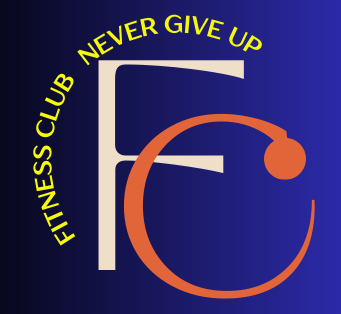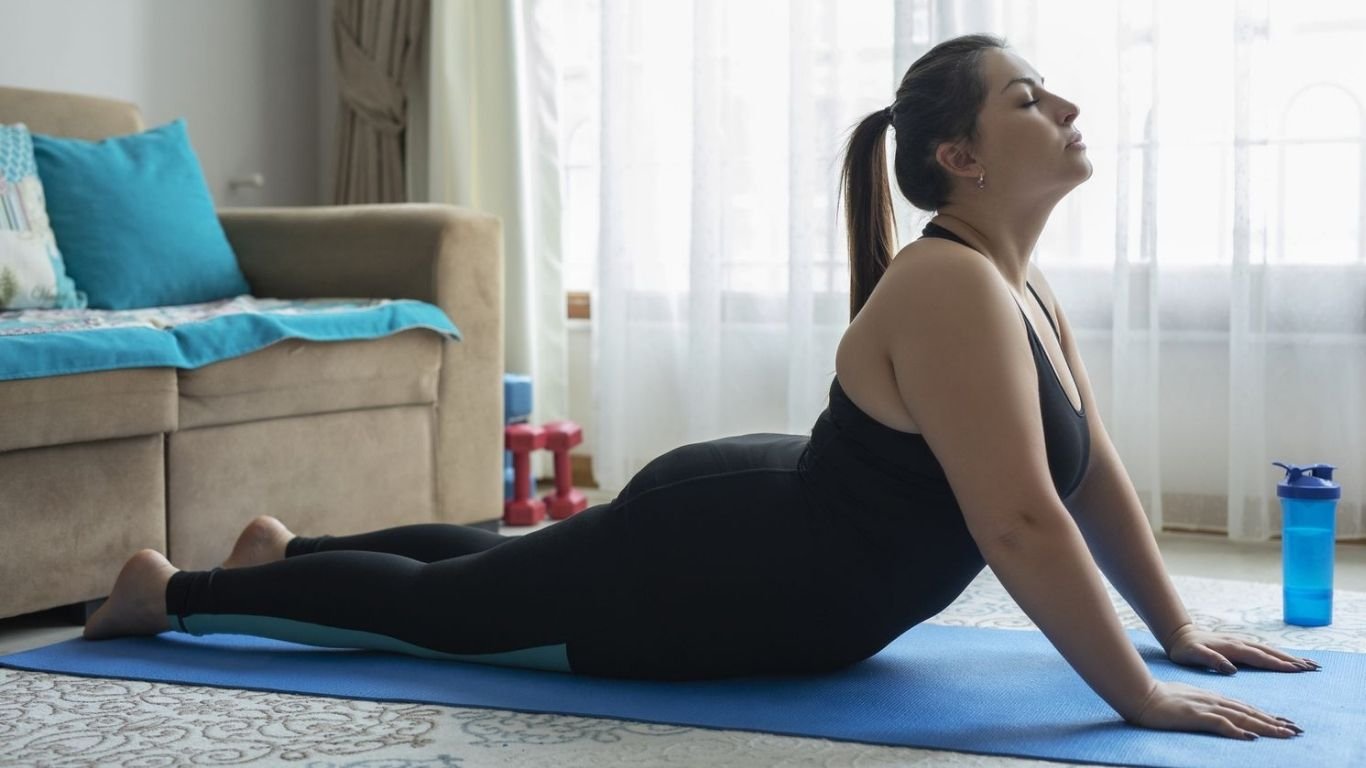Introduction
Want a toned, flat belly but short on time? This 10-min ABS workout is designed to help you sculpt your core. And achieve visible results in just 30 days—no gym or equipment needed! Whether you’re a beginner or a fitness enthusiast, these quick, effective exercises target your entire abdominal area. Helping you burn fat and build strength efficiently.
A strong core isn’t just about aesthetics—it improves posture, reduces back pain, and enhances overall fitness. By dedicating just 10 minutes a day. You can activate your upper abs, lower abs, and obliques with high-intensity moves that maximize calorie burn. The best part? You can do this routine anywhere, anytime!
In this guide, we’ll break down the best 10-min ABS workout to help you:
✔️ Burn stubborn belly fat with dynamic exercises
✔️ Strengthen your core for better stability
✔️ Boost metabolism for faster results
✔️ Stay consistent with a simple, time-efficient routine
Ready to transform your midsection? Let’s dive into this 30-day challenge and get you closer to a flatter, stronger belly with just 10 minutes a day!
How This 10-Min ABS Workout Works
Want a flat belly in just 30 days? This 10-min ABS workout is scientifically designed to maximize fat burn and strengthen your core efficiently. By combining high-intensity movements with targeted ab exercises, this routine activates your entire midsection—upper abs, lower abs, and obliques—while boosting metabolism for faster results.
Why It Works:
✅ Short & Effective – Just 10 minutes a day is enough to engage your core muscles without overtraining.
✅ Fat-Burning Intensity – The exercises keep your heart rate up, helping you burn calories even after the workout.
✅ No Equipment Needed – Bodyweight moves ensure you can do this anytime, anywhere.
✅ Progressive Challenge – As your strength improves, you can increase reps or intensity for continuous progress.
The Science Behind It:
This routine uses compound movements (like plank variations and leg raises) to engage multiple muscle groups, increasing calorie expenditure. Paired with isometric holds (such as hollow body holds), it builds endurance while tightening your core.
Stick with it for 30 days, pair it with a balanced diet, and you’ll see a leaner, stronger belly in no time! Ready to start? Let’s crush those abs!
The 10-Minute ABS Workout Routine for a Flat Belly
Want a stronger, leaner core in just 30 days? This 10-minute ABS workout is designed to torch belly fat, sculpt your midsection, and improve core strength—all in a quick, no-equipment routine. Perfect for busy schedules, this high-intensity circuit keeps your heart rate up while targeting every part of your abs for maximum results.
Exercise 1: Plank Hold (Core activation)
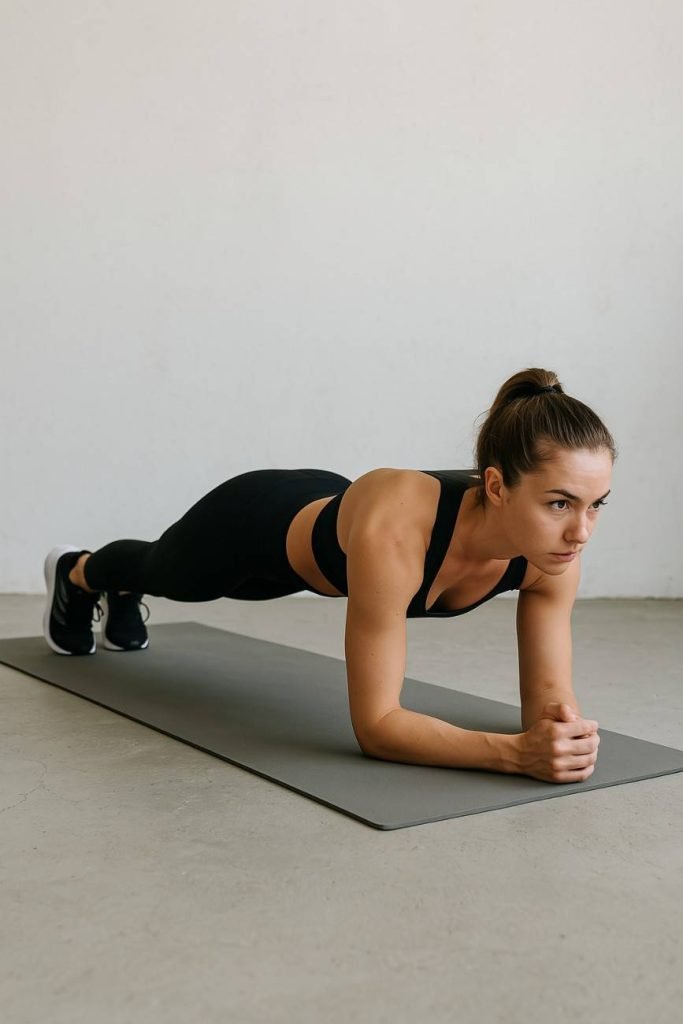
How to Perform Plank Hold
- Start Position: Begin in a push-up position. Place your forearms on the ground with elbows directly under your shoulders.
- Body Alignment: Keep your body in a straight line from head to heels. Engage your core, squeeze your glutes, and avoid sagging your hips.
- Head & Neck: Look down at the floor to keep your neck neutral.
- Hold: Maintain the position without moving for the desired duration.
Benefits of Plank Hold
- Strengthens Core Muscles: Targets abs, obliques, and lower back.
- Improves Posture: Builds stability and balance in the spine.
- Enhances Endurance: Increases muscular endurance over time.
- Tones Full Body: Works arms, shoulders, glutes, and legs.
- Reduces Back Pain: Builds strength in the muscles that support your spine.
Variations of Plank Hold
- Forearm Plank: Standard version, easier on wrists.
- High Plank: Performed with arms fully extended.
- Side Plank: Targets obliques and improves lateral stability.
- Plank with Leg Lift: Adds a glute and balance challenge.
- Plank to Push-Up: Dynamic version that works upper body strength.
How Long to Hold a Plank
- Beginners: Start with 15–30 seconds.
- Intermediate: Aim for 30–60 seconds.
- Advanced: Hold for 1–2 minutes or perform plank circuits.
- Progression Tip: Increase duration weekly or add variations.
Tips for Plank Hold
- Keep your body in a straight line.
- Don’t let your hips sag or pike up.
- Engage your core, glutes, and thighs.
- Breathe normally—don’t hold your breath.
- Use a mirror or take a video to check your form.
Potential Risks of Plank Hold
- Lower back strain if form breaks.
- Shoulder pain if elbows are not aligned properly.
- Wrist discomfort in high plank position.
- Neck tension from improper head alignment.
- Avoid holding too long—form matters more than duration.
Exercise 2: Bicycle Crunches
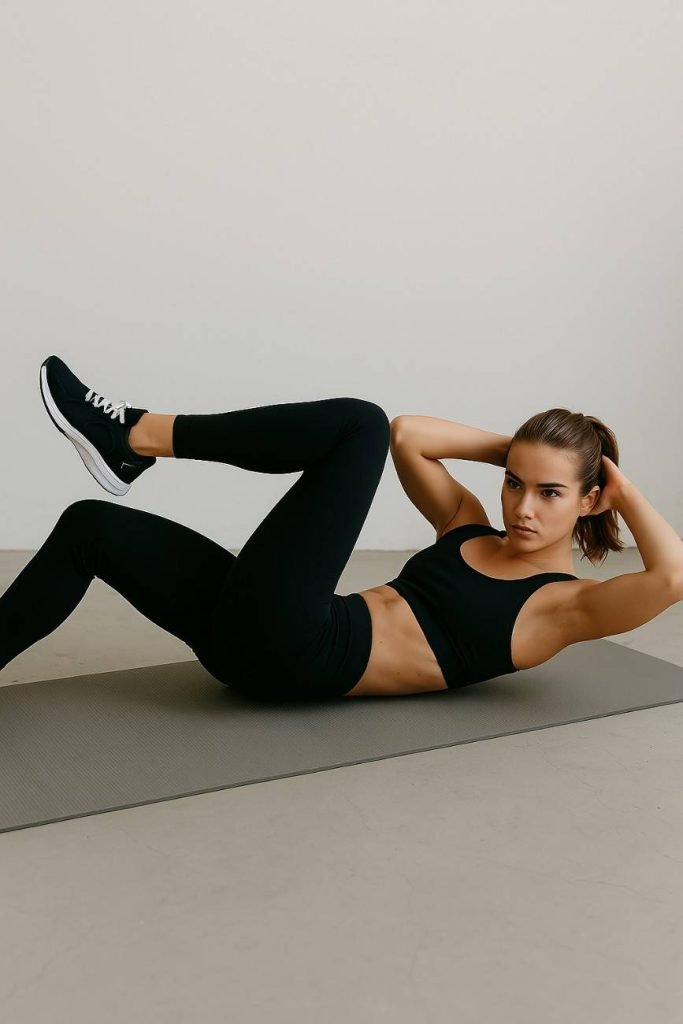
How to Perform Bicycle Crunches
- Starting Position: Lie flat on your back with your hands behind your head. Lift your shoulders off the mat and raise both legs, bending your knees at a 90-degree angle.
- Movement: Bring your right elbow toward your left knee while straightening your right leg. Then switch sides, bringing your left elbow to your right knee.
- Breathing: Exhale with each crunch and inhale between switches.
- Speed: Move in a controlled, twisting motion—avoid rushing.
Benefits of Bicycle Crunches
- Targets the Core: Works the upper abs, lower abs, and obliques simultaneously.
- Improves Coordination: Enhances mind-body connection with each side-switch.
- Boosts Core Endurance: Strengthens the muscles responsible for spinal support.
- Enhances Athletic Performance: Supports better balance and rotational movement.
- Burns Calories: A dynamic move that contributes to fat loss when done in circuits.
Variations of Bicycle Crunches
- Slow Bicycle Crunches: Slow down the tempo for better control and core engagement.
- Weighted Bicycle Crunches: Hold a light plate or medicine ball for added resistance.
- Leg-Lowered Bicycle Crunches: Keep legs lower to the ground for more intensity.
- Reverse Bicycle Crunches: Start with knees extended and crunch them inward instead.
- Suspended Bicycle Crunches (Advanced): Use TRX or resistance bands for added difficulty.
How Long to Do Bicycle Crunches
- Beginners: Start with 2 sets of 10–15 reps per side.
- Intermediate: Perform 2–3 sets of 20–30 reps per side.
- Advanced: Incorporate into timed circuits (30–60 seconds per round).
- Progressive Overload: Add reps or time weekly for consistent improvement.
Tips for Bicycle Crunches
- Keep your lower back pressed into the floor.
- Don’t pull on your neck—use your core to twist.
- Fully extend the leg with each rep to maximize range of motion.
- Keep the movement controlled, not jerky or rushed.
- Exhale as you crunch, inhale as you switch sides.
Potential Risks of Bicycle Crunches
- Neck strain if you tug your head forward.
- Lower back discomfort if core engagement is poor.
- Hip flexor fatigue if overused without proper form.
- Incorrect form may reduce the effectiveness and increase injury risk.
- Avoid if you have recent spinal injuries or severe back pain without medical clearance.
Exercise 3: Leg Raises
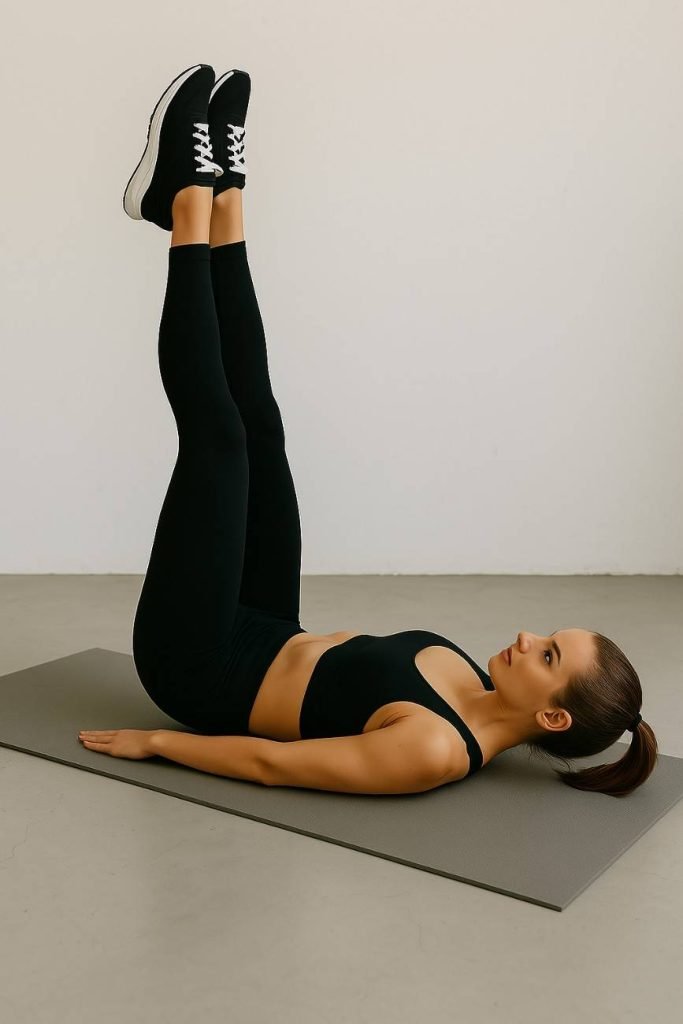
How to Perform Leg Raises
- Starting Position: Lie flat on your back with legs straight and arms at your sides or hands under your hips for support.
- Lift: Keeping legs straight, slowly raise them up together until they form a 90° angle with your torso.
- Lower: Lower your legs back down slowly without letting your feet touch the ground. Keep your core tight throughout.
- Breathing: Inhale as you lower the legs, exhale as you lift.
Benefits of Leg Raises
- Targets Lower Abs: One of the most effective exercises for lower abdominal muscles.
- Improves Core Strength: Engages deep core stabilizers.
- Hip Flexor Activation: Strengthens hip flexors and improves lower-body mobility.
- Supports Lower Back: Builds muscle to help support the lumbar spine (when done with proper form).
- No Equipment Needed: Great for home workouts.
Variations of Leg Raises
- Bent-Knee Leg Raises: Easier on the lower back; great for beginners.
- Weighted Leg Raises: Hold a dumbbell between feet or use ankle weights for added resistance.
- Hanging Leg Raises: Done from a pull-up bar; advanced and targets full core.
- Reverse Crunches: Lift hips off the floor at the top for greater lower ab activation.
- Flutter Kicks: A dynamic version focusing on endurance and core stability.
How Long to Do Leg Raises
- Beginners: 2 sets of 10–12 reps.
- Intermediate: 3 sets of 12–15 reps or 30–45 seconds per set.
- Advanced: 3–4 sets of 20+ reps or 60 seconds per set.
- Progression Tip: Add reps, sets, or resistance as you build core strength.
Tips for Leg Raises
- Keep core tight and press your lower back into the mat.
- Avoid letting your legs drop too fast—control the movement.
- Keep legs straight and together for maximum tension.
- If you feel strain in your lower back, place hands under glutes or modify with bent knees.
- Don’t hold your breath—breathe rhythmically with each rep.
Potential Risks of Leg Raises
- Lower back strain if core isn’t engaged or form breaks down.
- Neck tension if you crane your head forward—keep it relaxed.
- Hip flexor overuse if not balanced with core activation.
- Too much momentum reduces effectiveness and increases injury risk.
- Avoid if you have lumbar disc issues unless approved by a medical professional.
Exercise 4: Russian Twists
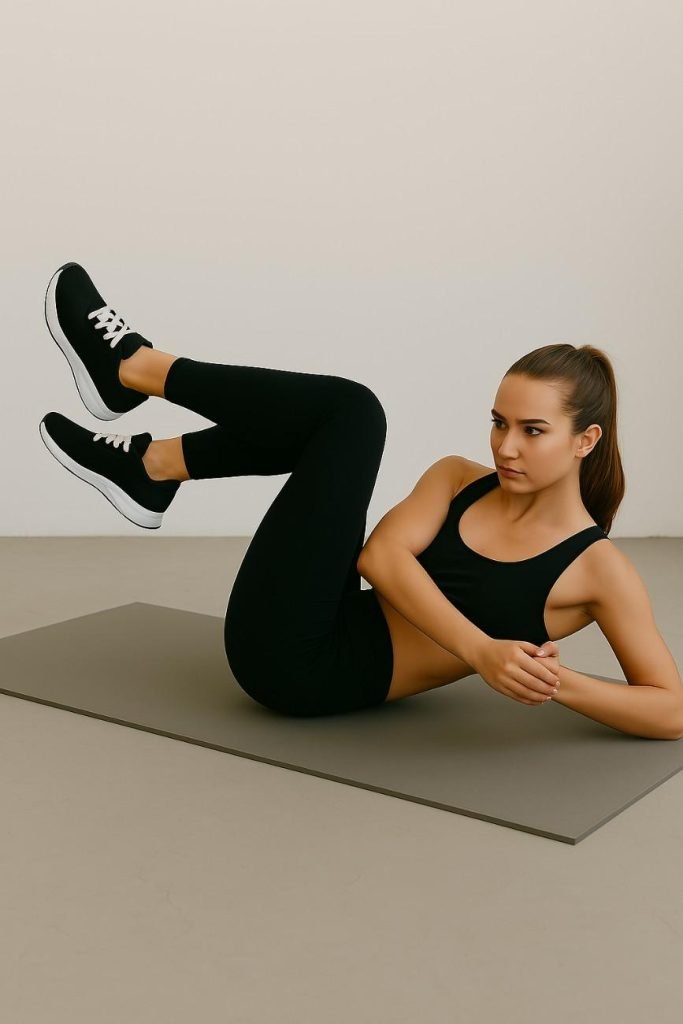
How to Perform Russian Twists
- Starting Position: Sit on the floor with knees bent and feet flat. Lean back slightly to create a V-shape with your torso and thighs.
- Lift Feet (Optional): For more intensity, lift your feet off the floor, balancing on your sit bones.
- Twist: Hold your hands together or a weight, and rotate your torso to one side, bringing your hands beside your hip. Then twist to the opposite side.
- Breathing: Exhale as you twist, inhale at the center.
Benefits of Russian Twists
- Targets Obliques: Engages the side abdominal muscles for a slimmer waistline.
- Improves Core Rotation: Boosts functional rotational strength and control.
- Enhances Balance & Stability: Strengthens stabilizers by working in an unstable seated position.
- Low Equipment Needs: Can be done bodyweight or with simple gear (dumbbell, medicine ball).
- Engages Entire Core: Also works rectus abdominis and transverse abdominis.
Variations of Russian Twists
- Bodyweight Russian Twists: Ideal for beginners, no added resistance.
- Weighted Russian Twists: Use a dumbbell, medicine ball, or kettlebell.
- Feet-Elevated Twists: Lift your feet off the ground for added core challenge.
- Seated Twist with Resistance Band: Adds controlled resistance through rotation.
- Standing Russian Twists: Performed with a cable machine for spinal-friendly rotation.
How Long to Do Russian Twists
- Beginners: 2 sets of 10–12 reps per side.
- Intermediate: 3 sets of 15–20 reps per side or 30–45 seconds.
- Advanced: 3–4 sets of 20–30 reps per side or 60 seconds with weight.
- Progression Tip: Increase reps or resistance, or slow the tempo to intensify.
Tips for Russian Twists
- Keep your core tight and spine straight—avoid rounding your back.
- Move from your torso, not just your arms.
- Keep your feet off the ground (if possible) without swinging them.
- Control each twist—avoid using momentum.
- Look straight ahead or follow your hands to keep form aligned.
Potential Risks of Russian Twists
- Lower back strain if you round your spine or twist without core engagement.
- Hip flexor fatigue when feet are elevated too long.
- Neck discomfort if your head twists separately from your torso.
- Risky for spinal injuries due to the twisting motion—avoid if you have herniated discs or similar issues.
- Improper form or using too much weight can reduce core activation and increase injury risk.
Exercise 5: Mountain Climbers
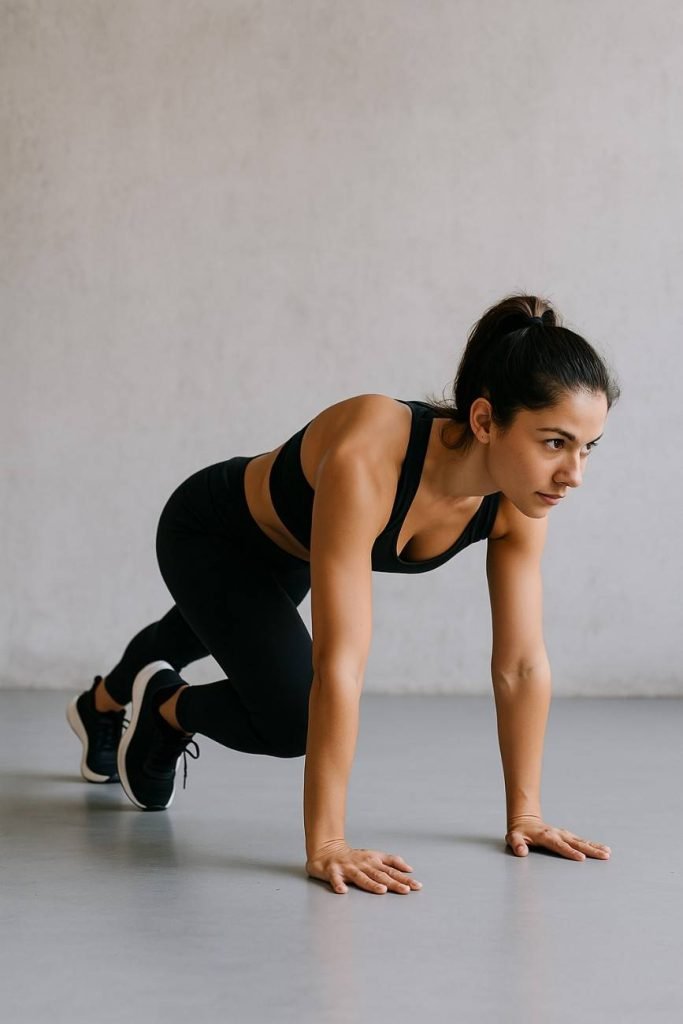
How to Perform Mountain Climbers
- Start Position: Begin in a high plank position with hands directly under shoulders and body in a straight line from head to heels.
- Engage Core: Keep your core tight and hips level.
- Drive Knees: Quickly drive one knee toward your chest, then switch legs in a running motion.
- Tempo: Move at a brisk pace while keeping control and form intact.
- Breathing: Inhale and exhale rhythmically; don’t hold your breath.
Benefits of Mountain Climbers
- Full-Body Workout: Engages core, shoulders, chest, quads, and glutes.
- Cardio & Strength Combo: Boosts heart rate while building muscular endurance.
- Fat Burning: Great for fat loss when included in high-intensity routines.
- Improves Coordination & Agility: Encourages quick foot movement and balance.
- No Equipment Needed: Can be done anywhere, making it ideal for home workouts.
Variations of Mountain Climbers
- Slow Mountain Climbers: Controlled movement to emphasize core engagement.
- Cross-Body Climbers: Drive knees toward the opposite elbow to target obliques.
- Spider Climbers: Bring knees outside the elbow for increased hip mobility.
- Incline Climbers: Hands on a bench for less intensity (great for beginners).
- Elevated Feet Climbers: Feet on a bench or step for more upper-body challenge.
- Resistance Band Climbers: Add a mini band around your feet for extra tension.
How Long to Do Mountain Climbers
- Beginners: 2 sets of 20–30 seconds.
- Intermediate: 3 sets of 30–45 seconds or 20 reps per side.
- Advanced: 3–4 sets of 60 seconds or add them to HIIT circuits.
- Progression Tip: Increase time, speed, or reps for greater fat-burning impact.
Tips for Mountain Climbers
- Keep hips level—avoid bouncing or lifting your butt.
- Drive knees straight toward your chest with control.
- Keep shoulders over wrists at all times.
- Stay light on your toes for quick, explosive motion.
- Maintain a tight core to avoid lower back strain.
Potential Risks of Mountain Climbers
- Wrist strain from extended pressure in plank position.
- Lower back pain if hips sag or core is not properly engaged.
- Knee impact if feet slam down too hard or lack control.
- Neck tension from craning forward—keep head in line with spine.
- Not ideal for people with shoulder injuries or weak core stability.
Exercise 6: Flutter Kicks
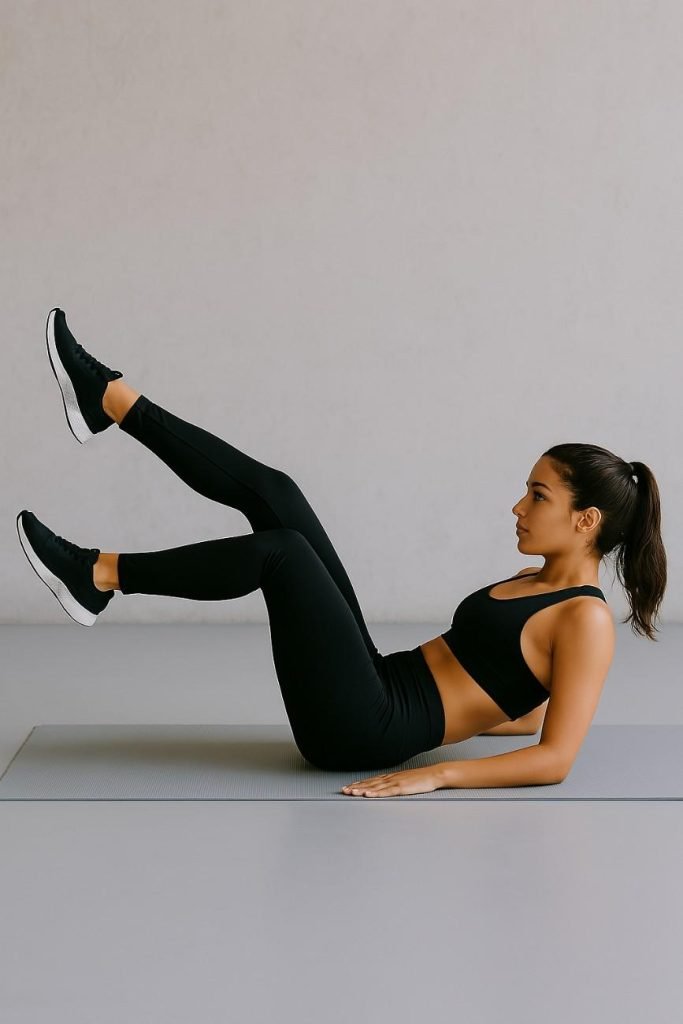
How to Perform Flutter Kicks
- Starting Position: Lie on your back with your legs extended and arms by your sides or tucked under your glutes for support.
- Lift: Raise both legs off the ground about 6–12 inches, keeping them straight and toes pointed.
- Flutter Motion: Alternately kick your legs up and down in a quick, controlled scissor-like motion.
- Breathing: Breathe steadily throughout—don’t hold your breath.
- Core Engagement: Keep your abs tight and lower back pressed into the floor.
Benefits of Flutter Kicks
- Strengthens Lower Abs: Directly targets the hard-to-tone lower abdominal muscles.
- Improves Core Endurance: Trains your core to stay engaged under continuous motion.
- Enhances Hip Flexor Strength: Boosts mobility and stability around the pelvis.
- Supports Fat Burn: High-rep or timed flutter kicks increase calorie expenditure.
- No Equipment Required: Perfect for home, gym, or travel workouts.
Variations of Flutter Kicks
- Vertical Flutter Kicks (Standard): Legs alternate up and down.
- Horizontal Flutter Kicks: Legs move side to side like scissors (scissor kicks).
- Weighted Flutter Kicks: Hold a small dumbbell between your feet or wear ankle weights.
- Incline Flutter Kicks: Performed on a decline bench for added resistance.
- Flutter Kicks with Crunch Hold: Combine with an upper body crunch to engage upper abs.
How Long to Do Flutter Kicks
- Beginners: 2 sets of 20–30 seconds or 15 reps per leg.
- Intermediate: 3 sets of 30–45 seconds or 20–25 reps per leg.
- Advanced: 3–4 sets of 60 seconds or add to HIIT/core circuits.
- Progression Tip: Increase time, reps, or add resistance for a challenge.
Tips for Flutter Kicks
- Keep your lower back on the floor—press it down to avoid strain.
- Move legs in small, controlled kicks, not big swings.
- Avoid letting your legs touch the ground between reps.
- Keep your neck and shoulders relaxed unless adding a crunch.
- If needed, modify by bending the knees slightly to reduce lower back pressure.
Potential Risks of Flutter Kicks
- Lower back strain if the core is not properly engaged.
- Hip flexor fatigue with poor form or excessive reps.
- Neck tension if upper body is lifted improperly during variation.
- Risky for individuals with existing lumbar spine issues—modify or skip if advised.
- Avoid holding your breath—it can increase pressure and reduce endurance.
Exercise 7: Reverse Crunches
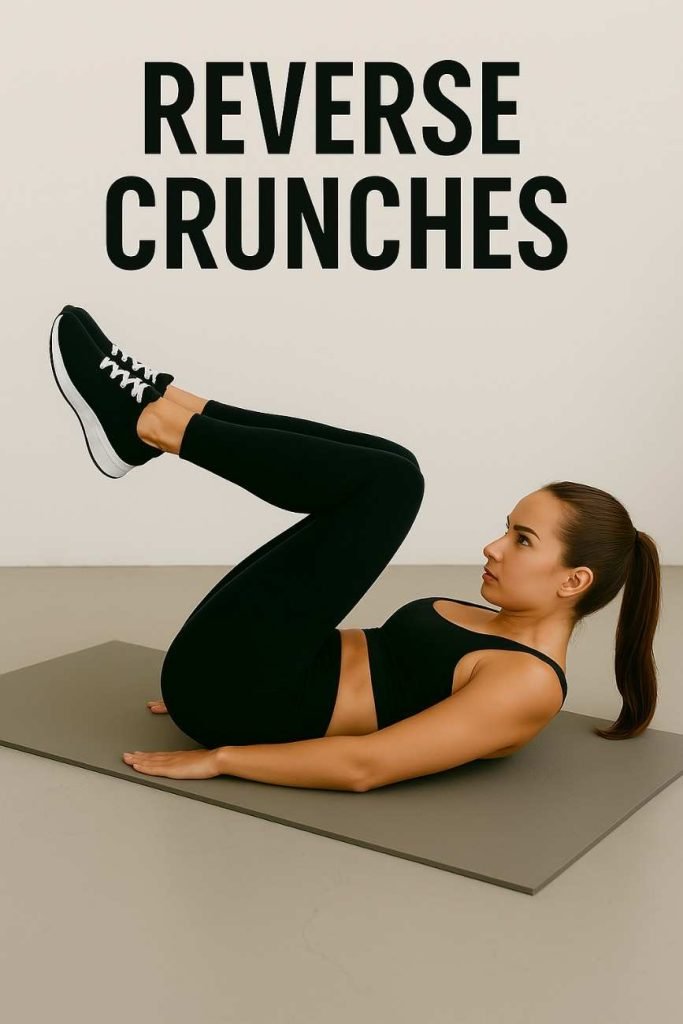
How to Perform Reverse Crunches (Deep Core)
- Starting Position: Lie flat on your back with arms at your sides and palms down. Bend your knees and lift your feet off the floor so your thighs are perpendicular to the ground.
- Lift: Engage your core and slowly curl your hips off the floor, bringing your knees toward your chest. Your lower back should gently lift off the mat.
- Lower: Slowly lower your hips back down to the floor without letting your feet touch the ground.
- Breathing: Exhale as you lift, inhale as you lower.
Benefits of Reverse Crunches (Deep Core)
- Targets Lower Abs: Activates the deep transverse abdominis and lower rectus abdominis.
- Low Back-Friendly: Safer on the spine compared to traditional crunches.
- Improves Pelvic Stability: Trains the lower core muscles that support spinal alignment.
- Tones the Midsection: Helps define the lower belly area.
- Improves Functional Core Strength: Great for real-life movements and injury prevention.
Variations of Reverse Crunches (Deep Core)
- Reverse Crunch with Leg Extension: Extend legs straight out after each crunch to increase difficulty.
- Weighted Reverse Crunch: Hold a dumbbell or medicine ball between knees.
- Incline Reverse Crunch: Perform on a decline bench for more resistance.
- Slow Tempo Reverse Crunch: Emphasize the eccentric (lowering) phase for deeper core activation.
- Reverse Crunch with Pulse: Add a small extra lift at the top for an extra burn.
How Long to Do Reverse Crunches (Deep Core)
- Beginners: 2 sets of 10–12 reps.
- Intermediate: 3 sets of 12–15 reps.
- Advanced: 3–4 sets of 20+ reps or add them into time-based core circuits (30–45 seconds).
- Progression Tip: Increase reps or add variations as your core strength improves.
Tips for Reverse Crunches (Deep Core)
- Use controlled movement—don’t use momentum or swing your legs.
- Keep your neck and shoulders relaxed on the mat.
- Focus on lifting from your lower abs, not your legs.
- Keep your knees bent at 90 degrees for better targeting of the deep core.
- Exhale at the top of the lift for maximum core contraction.
Potential Risks of Reverse Crunches (Deep Core)
- Lower back strain if form breaks and hips aren’t lifted with control.
- Neck tension if shoulders lift off the mat during the movement.
- Hip flexor dominance if the core isn’t properly engaged.
- Can aggravate existing spinal conditions if done incorrectly—seek guidance if you have disc issues.
- Avoid jerky movements—smooth, controlled form is critical.
Exercise 8: Side Plank
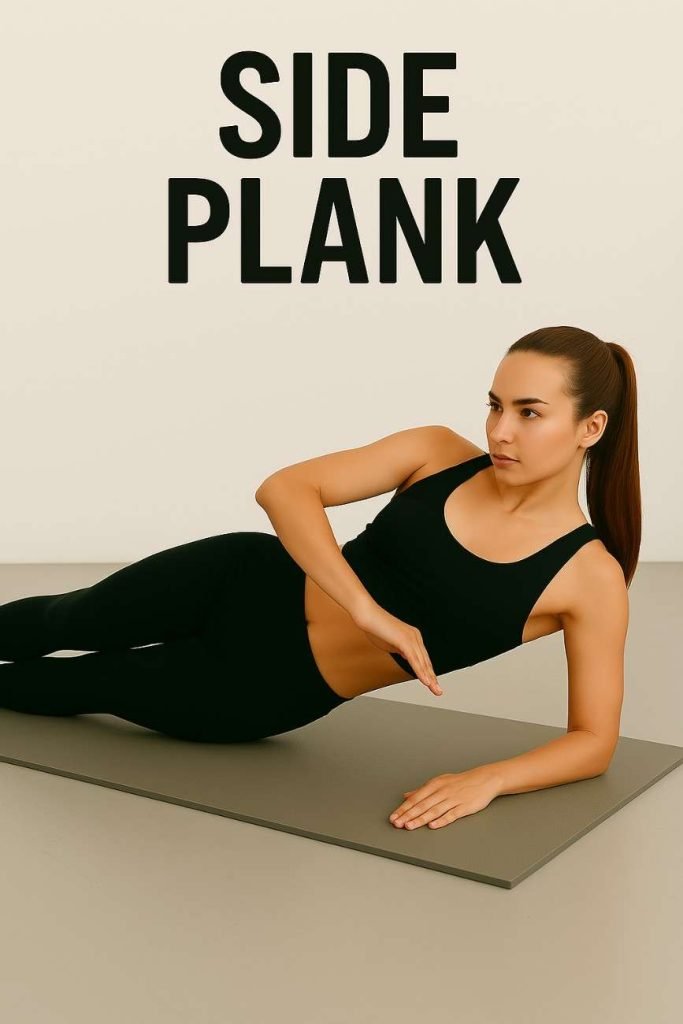
How to Perform Side Plank (Each Side, Oblique Focus)
- Starting Position: Lie on your side with legs extended and stacked on top of each other. Position your elbow directly under your shoulder.
- Lift: Engage your core and lift your hips off the floor to form a straight line from head to heels.
- Hold: Keep your top hand on your hip or extended upward. Maintain alignment—don’t let hips sag or rotate forward.
- Switch Sides: After holding, lower slowly and repeat on the other side.
- Breathing: Breathe steadily throughout; do not hold your breath.
Benefits of Side Plank (Each Side, Oblique Focus)
- Targets Obliques: Strengthens side abdominal muscles, crucial for waist definition and spinal support.
- Improves Core Stability: Trains deep core muscles for balance and posture.
- Reduces Risk of Injury: Enhances lateral stability, lowering chances of back and hip strain.
- Supports Shoulder Stability: Builds endurance and control in the shoulder joint.
- Enhances Mind-Muscle Connection: Builds better awareness and control of body alignment.
Variations of Side Plank (Each Side, Oblique Focus)
- Modified Side Plank: Keep bottom knee on the floor for support—great for beginners.
- Side Plank with Leg Lift: Raise top leg for added glute and core challenge.
- Side Plank Reach-Under: Twist the top arm under your torso to engage the obliques more deeply.
- Side Plank on Hand: Perform on a straight arm for more shoulder engagement.
- Elevated Side Plank: Place feet on a bench for a greater range of motion.
How Long to Hold Side Plank (Each Side, Oblique Focus)
- Beginners: Hold for 15–20 seconds per side.
- Intermediate: Hold for 30–45 seconds per side.
- Advanced: Hold for 60+ seconds per side or perform in time-based circuits.
- Progression Tip: Add reps, longer holds, or advanced variations as you build strength.
Tips for Side Plank (Each Side, Oblique Focus)
- Keep your body in a straight line—don’t let hips sag or twist.
- Make sure your elbow is directly under your shoulder to avoid strain.
- Engage your obliques and glutes to support the lift.
- Keep your neck neutral—gaze forward or up at your top hand.
- Use a mat or cushion under your elbow if needed for comfort.
Potential Risks of Side Plank (Each Side, Oblique Focus)
- Shoulder strain if elbow or hand placement is off.
- Wrist or elbow discomfort with extended holds (use padding).
- Lower back pain if hips are not lifted or core is disengaged.
- Neck strain from improper head alignment.
- May be difficult for those with core weakness or balance issues—modify as needed.
Pro Tips for Better Results
1️⃣ Mind-Muscle Connection
- Squeeze & Hold: At the top of each rep, consciously contract your abs for 1 second
- Visualize: Imagine your abs “zipping up” toward your spine during every movement
**2️⃣ Breathing for Better Definition
- Exhale sharply during the contraction phase (e.g., when twisting in bicycle crunches)
- Inhale deeply during the release to oxygenate muscles
**3️⃣ Progressive Overload Tricks
- Add ankle weights (start with 2-5lbs) for leg raises/flutter kicks
- Use a medicine ball (8-12lbs) for Russian twists
- Try tempo training: 3-second lowering phase in reverse crunches
**4️⃣ Nutrition Hacks for Visible Abs
- Drink 16oz water before workout to enhance muscle engagement
- Consume 20g lean protein within 30 minutes post-workout
- Reduce bloating by limiting salt & carbonation 2 hours before training
**5️⃣ Recovery Secrets
- Do 1 minute of diaphragmatic breathing post-workout to relax core muscles
- Use a foam roller on hip flexors to prevent “tight abs, sore back” syndrome
**6️⃣ Advanced Activation Techniques
- Pre-exhaust with 30-second hollow hold before starting routine
- Add vibration training (place hands on vibrating platform during planks)
Supporting Your Flat Belly Goal
1️⃣ Beyond the 10-Min Workout: Total Core Activation
- Add 5 minutes of cardio finishers (jump rope, burpees) post-workout to boost fat burn
- Incorporate full-body strength training 3x/week – compound lifts (squats, deadlifts) increase metabolic rate
**2️⃣ The Nutrition Edge
- Follow the “3-Plate Rule”: ½ plate veggies, ¼ lean protein, ¼ complex carbs at every meal
- Smart Swaps:
- Cauliflower rice instead of white rice (saves 150 cals/cup)
- Greek yogurt instead of sour cream (adds 10g protein)
- Hydration Hack: Add lemon + cucumber to water – reduces bloating naturally
**3️⃣ Lifestyle Boosters
- Sleep for Abs: Aim for 7-9 hours – studies show poor sleep increases belly fat storage by 32%
- Stress Less: 5 minutes of daily box breathing lowers cortisol (the belly fat hormone)
- Posture Perfect: Engage your core when sitting – burns extra 100 calories/day
**4️⃣ Supplement Support (Science-Backed)
- Probiotics: Reduce bloating and improve digestion
- Omega-3s: Help reduce visceral fat
- Green Tea Extract: Boosts metabolism by 4-5%
**5️⃣ Progress Tracking That Works
- Weekly Measurements: Waist circumference is more reliable than scale weight
- Progress Photos: Take every Sunday at same time/lighting
- Strength Markers: Track how many leg raises you can do with perfect form
Pro Tip: Combine this 10-min abs routine with 10,000 steps daily for 2x faster results – research shows this combo reduces waist size 40% faster than exercise alone!
Expected Results in 30 Days:
🔥 The 30-Day Progression Timeline
1: Week
- Core endurance improves (20% longer plank holds)
- Reduced bloating (better mind-muscle connection)
- Initial muscle soreness (sign of activation)
2:Week
- Clothes fit looser around waist (1-2cm reduction)
- Exercises feel more controlled (strength gains)
- Visible “morning abs” when hydrated
3:Week
- Noticeable muscle definition when flexed
- 30-50% increase in exercise reps with good form
- Natural posture improvement (core carries you taller)
4:Week
- Clear upper ab definition (for most body types)
- 2-4cm waist circumference reduction
- Routine becomes habit (no more workout dread)
📊 Science-Backed Outcome Ranges
| Result | Average Improvement | Top 20% Achievers |
|---|---|---|
| Waist Reduction | 2-5cm | 6-8cm |
| Core Strength | 40% better endurance | 2x longer holds |
| Body Fat % | 1-2% drop | 3-4% drop |
Key Factors Affecting Results:
✔️ Consistency (5+ sessions/week)
✔️ Nutrition (80% clean eating)
✔️ Recovery (7+ hours sleep)
✔️ Hydration (3L water/day)
Conclusion:
Embarking on a 10-minute daily ABS workout for 30 days is a powerful commitment to transforming your core and achieving a flatter belly. While the exercises themselves are crucial, remember that this journey is multifaceted. Consistency is your ultimate tool; showing up daily, even for just 10 minutes, builds momentum and solidifies new habits.
This focused routine, featuring exercises like planks and bicycle crunches, effectively targets all areas of your core—from the deep transverse abdominis to the rectus abdominis and obliques. By strengthening these muscles, you not only work towards a more defined midsection but also enhance overall core stability, improve posture, and reduce the risk of back pain.
However, a flat belly in 30 days isn’t solely about crunches and planks. For optimal results, complement your consistent ABS workouts with a balanced, nutrient-rich diet, adequate hydration, and sufficient sleep. Reducing processed foods and focusing on whole, unprocessed options will significantly aid in shedding any excess body fat that might be obscuring your abdominal muscles.
By committing to these 10 minutes each day, maintaining proper form, and embracing a holistic approach to your well-being, you’re not just aiming for a flatter belly; you’re building a stronger, healthier, and more confident you. The next 30 days are an opportunity to redefine your core and witness the remarkable changes that consistent, dedicated effort can bring. Start today, stay consistent, and unlock the results you desire.
